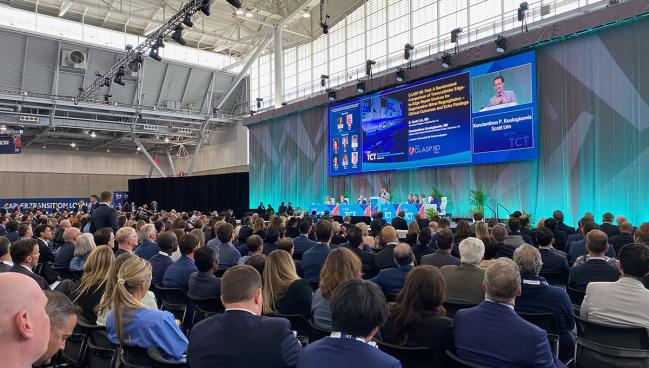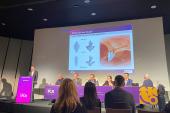Pascal TEER Device as Good as MitraClip in Head-to-Head CLASP IID
The device met its primary noninferiority endpoint for safety and efficacy against MitraClip in degenerative MR patients.

BOSTON, MA—(UPDATED) Patients with severe symptomatic degenerative mitral regurgitation (MR) ineligible for surgery fare just as well when treated with the Pascal device (Edwards Lifesciences) as those treated with MitraClip (Abbott), according to the CLASP IID study.
The results, which were presented as a late-breaking clinical trial at TCT 2022 and published simultaneously in JACC: Cardiovascular Interventions, come just 2 days after the US Food and Drug Administration approved the Pascal transcatheter edge-to-edge repair (TEER) system for the treatment of degenerative MR, making it just the second device available in the US.
“The CLASP IID trial is the first randomized, controlled trial to directly compare the two TEER therapies and further establishes the safety and effectiveness of mitral valve TEER for degenerative mitral regurgitation patients with prohibitive surgical risk,” said study investigator Konstantinos Koulogiannis, MD (Atlantic Health System Morristown Medical Center, NJ), during a press conference. “It met its primary safety and effectiveness endpoints, with the Pascal system demonstrating low composite major adverse events and a significant, sustained MR reduction.”
Lead investigator D. Scott Lim, MD (University of Virginia Health System Hospital, Charlottesville, VA), said the introduction of a second device is important, as it provides physicians and patients with options.
“The two devices have different design features that I think may be beneficial in different anatomies,” said Lim.
For example, Pascal’s hollow nitinol-frame construction allows it to close passively and flex during systole and diastole. The device also elongates, allowing it to be maneuvered into anatomies with denser mitral chords, said Lim. The clasps for grasping the mitral leaflets can be operated in tandem or independently, allowing for staged leaflet capture and adjustment, and a central spacer helps to bridge the coaptation gap so the leaflets aren’t pulled as tightly together.
Federico Asch, MD (MedStar Health/Georgetown University, Washington, DC), who wasn’t involved in CLASP IID, congratulated the researchers, saying the field has now entered a new era. “We’ve been building a lot of data with MitraClip as a device, but as a composite, it’s important to now show that TEER works. There are going to be patients who are better candidates for one [device] or another. I don’t think we have that answer right now,” he said.
The two devices have different design features that I think may be beneficial in different anatomies. D. Scott Lim
Speaking with TCTMD, Janarthanan Sathananthan, MBChB (University of British Columbia/Vancouver General Hospital/St. Paul’s Hospital, Vancouver, Canada), who wasn’t involved in the study, echoed Asch’s comments.
“I think it’s beneficial to have another device to offer TEER as an option,” he said. “We’ve seen the struggles that we’ve had with screening for transcatheter mitral valve replacement. We have high exclusion rates, so having another device that offers a therapeutic option for edge-to-edge repair is beneficial. CLASP IID also reinforces the benefits of edge-to-edge repair”
Interim Analysis of 180 Patients
The CLASP IID study included 180 patients enrolled at 43 sites in the United States, Canada, and Europe between 2018 and 2021. Up to 300 patients are planned for enrollment. However, interim analyses were planned for 180, 210, and 240 patients provided the sample size was deemed sufficient for analyzing the primary endpoint. At 180 patients, the interim analysis proceeded because the predictive probability for study success exceeded 96.5%, say investigators.
The current analysis included 117 patients treated with Pascal and 63 treated with MitraClip, with frailty the most common reason that patients in both treatment groups were ineligible for surgery. Both were well matched, but those who received the Pascal device were more likely to have undergone prior aortic valve surgery or TAVI. Two-thirds of patients received the Pascal implant;24.1% received the newer Pascal Ace device, which is narrower, has a shorter profile, and longer clasps; and 8.6% received a combination. In the MitraClip arm, 39.3% were treated with an NT/NTR/XTR device while 60.7% received the newer-generation G4 device, which has independent clasps for gripping the mitral leaflets.
With respect to major adverse events—a composite safety endpoint that included cardiovascular death, stroke, MI, need for renal replacement therapy, severe bleeding, and nonelective mitral valve reintervention—the Pascal system met the margin for noninferiority when compared with MitraClip (3.4% with Pascal vs 4.8% with MitraClip). At 30 days, the 1.3% difference in major adverse events had a one-sided upper confidence boundary of 5.1%, which fell within the prespecified 15% noninferiority margin.
With Pascal, there was one cardiovascular death, three severe bleeds, and one mitral-valve reintervention. In the MitraClip group, there was one cardiovascular death and two severe bleeds.
In terms of effectiveness, the proportion of patients with MR ≤ 2+ at 6 months 96.5% with Pascal and 96.8% with MitraClip. The absolute difference of 0.3% had a one-sided lower confidence boundary of 6.2%, which fell within the prespecified noninferiority margin of 18%. Regardless of device, all patients achieved MR ≤ 2+ at discharge while 87.2% and 88.5% of the Pascal- and MitraClip-treated patients had MR ≤ 1+ at discharge. At 6 months, 83.7% of the Pascal-treated patients and 71.2% of the MitraClip-treated patients had sustained MR ≤ 1+, suggesting there was “some loss of efficacy over the same course of follow-up” with MitraClip, according to investigators. Mean valve gradients were stable over time in both groups.
There are going to be patients who are better candidates for one [device] or another. I don’t think we have that answer right now. Federico Asch
Commenting on this signal, Lim told TCTMD: “Obviously, this is only 6 months, only 180 patients . . . We have to see if this bears out over the entire cohort over much longer follow-up. If it does, then I think it is something operators will consider. It is mirrored in at least two other publications out of Europe that when they compared [Pascal] to MitraClip, [they] seemed to find a decrease in efficacy with the MitraClip patients. It may bear out, but right now it’s a little early to say.”
Sathananthan pointed out that CLASP IID does have limitations, most notably the low patient numbers. However, a second device, one that appears to have less residual MR than that seen with MitraClip, is a valuable addition. To TCTMD, Sathananthan said one of the conundrums faced by operators who’ve performed edge-to-edge repair is that the severity of MR can be underestimated immediately after the procedure. Then, at follow-up, it’s not uncommon for MR to be a little bit higher than expected.
“So, that sustained benefit [with Pascal] is promising,” he said, calling it a signal that is worth watching in the larger cohort and over long-term follow-up. “It’s nice to try to get surgical-like repair results at the end. All of this is positive for the field.”
Anita Asgar, MD, MSc (Montreal Heart Institute, Canada), one of the panelists during the late-breaking science presentation, called CLASP IID an important study for TEER as it highlights the safety of the procedure, but also cautioned against making much of the direct comparison given the small number of patients, especially since just 37 patients in the MitraClip arm received the new-generation G4 device.
Another panelist, David Cohen, MD (St. Francis Hospital, Roslyn, NY), pointed out there is observational data suggesting that achieving MR ≤ 1+ is better for patients with degenerative MR. If a difference between MitraClip and Pascal emerges with respect to these sustained MR reductions, he said, it could be a factor when choosing devices.
Quality of Life and Functional Outcomes
Patients in both treatment arms had significant improvements in functional capacity and quality of life when compared with baseline, but there was no difference between devices. Procedure times were longer with the Pascal device (88 vs 79 minutes), but declined over time, suggesting there is a small learning curve with the device. Most of the participating sites did not have prior experience with the Pascal device prior to CLASP IID, the researchers point out.
Lim said that one advantage of MitraClip is the extent of operator experience, noting that operators may lean towards it because they are comfortable implanting it. In terms of anatomy, more complicated or thicker mitral leaflets requiring mechanical closure might also be suitable for MitraClip, he said.
The full trial has completed enrollment and patients are currently being followed. They hope to present data from the full 300-patient cohort early next year, said Lim.
The Pascal system has CE Mark approval in Europe for both MR and tricuspid regurgitation.
There are ongoing studies comparing TEER with MitraClip versus surgical mitral valve repair in patients with degenerative MR. One of those studies, PRIMARY, is a superiority trial funded by the National Institutes of Health with a planned enrollment of 450 patients at all levels of surgical risk. The other study is REPAIR MR, a noninferiority study, testing MitraClip versus valve repair surgery in degenerative MR patients at intermediate risk. Results from both trials aren’t expected for several years.
The CLASP IIF study is also ongoing. In that study, investigators are comparing Pascal to MitraClip in patients with functional MR and prohibitive surgical risk.
Michael O’Riordan is the Managing Editor for TCTMD. He completed his undergraduate degrees at Queen’s University in Kingston, ON, and…
Read Full BioSources
Lim SD, Smith RL, Gillam LD, et al. Randomized comparison of transcatheter edge-to-edge repair for degenerative mitral regurgitation in prohibitive surgical risk patients. J Am Coll Cardiol Intv. 2022;Epub ahead of print.
Disclosures
- The CLASP IID trial was funded by Edwards Lifesciences.
- Lim reports consulting for Philips, Venus, and Valgen and reports research grants from Abbott, Boston Scientific, Edwards Lifesciences, and Medtronic.





Comments